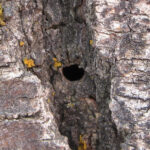Honeylocust Borer
Bark Beetles & Boring Insects
Honeylocust borer (Agrilus difficilis) is a species of metallic wood-boring beetle that infests and damages honeylocust trees (Gleditsia triacanthos). The larvae of the borer feed on the sapwood and heartwood of the tree, causing structural weakness and reducing the tree's overall health.
Adults are typically around 5-7mm in length and have metallic green or bronze wings. They lay their eggs on the bark of honeylocust trees, and the larvae tunnel into the trunk and branches of the tree after hatching. This tunneling can cause the tree's bark to crack and eventually become infested with fungi and other insects.
The damage caused by the honeylocust borer is often noticed when the tree begins to show wilting leaves and dieback in the crown. In severe cases, the tree may eventually die, especially if it is already weakened or stressed by other factors such as drought, disease, or damage from construction.
Management of honeylocust borer infestations involves monitoring the tree for signs of damage and treating the tree with insecticides if necessary. Proper care of the tree, such as watering and fertilizing, can also help to reduce the likelihood of an infestation. In some cases, removing heavily infested branches or trees may be necessary to prevent the spread of the pest to other trees.
Overall, the best way to prevent an infestation of honeylocust borer is to maintain the overall health of your trees by providing them with proper care and attention. Regular monitoring and prompt treatment of infestations can help to minimize damage and keep your trees healthy and strong.



